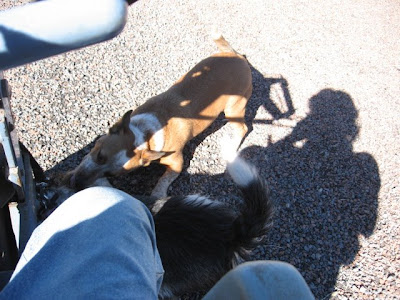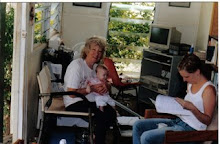It also, it seems, has ghosts.
The modest, one-story building clings to a bluff overlooking an expanse of reedy-swamp and the ruins of a large heiau, or, as I learned, temple platform. A narrow dirt road leads down into the jungley forest behind the Y, and right to monumental pile of lava rocks, the ruins of the Ulupo Heiau. A lot of people here think that the heiau, the swamp and environs, and by extension the YMCA, the churches that line the highway near it and the big hospital on top of the hill are all haunted.
But, we're practical people, don't worry about ghosts, and we're happy at the Y. My husband swims laps on one side of the sparkling turquoise pool while ladies of a certain age, in big sun hats and sunglasses, do Aqua Aerobics at the shallow end. I keep my fair skin fair by staying indoors trudging the treadmill and watching Oprah on the wall-mounted TV, then I lift weights for a while and watch the yoga students tying themselves in knots in their glassed-in classroom. It's very satisfying.
One afternoon I'd finished my workout, but my husband was still plowing up and down the pool, so I asked the sleepy-eyed young woman at the desk, "Excuse me, is that a swamp back there?"
"Yeah," she answered, showing her disdain for anyone over 50 by examining her eggplant-purple chipped fingernail polish and refusing eye contact.
"Oh, can I go back there?" I said, a bit too enthusiastically.
"Yeah," she shrugged and glanced at the clock - maybe close to quitting time for her. "They say it's haunted, so be careful. Don't get close to the water and stay off the heiau." She stared straight through me with her lavender contact lenses.
"What's a heiau?" I asked, ignoring what I thought was her attempt to scare me away.
She idly thumbed through Tattooing Magazine, maybe trying to decide whether to have an eagle, a bleeding heart, or a giant hibiscus added to the dead-blue and black pictures gracing her right arm. "Heiau?" I must be really dumb not to know that. "A heiau is a real old Hawaiian temple. That's what's back there."
The phone rang, she answered, and looking at me as if she wished me gone, switched to Hawaiian pidgin. "Hey, sistah! Howzit? Wassup? Naw, got me one malahini heah."
I decided to go off and see what I could see, ghosts or no. It was still light.
A dirt path leads down past a huge pile of natural lava rocks the size of big watermelons. It just looks as if some giant truck just dumped it there, and at first, that's what I thought had happened. There's is no rock like that in this part of the island, and these rocks had to come from far away. Just looking at the pile at first, you can't tell that it has any particular shape.
An historical plaque installed by the State Department of Agriculture in front of the platform admonishes in large letters: "STAY OFF THE HEIAU!" and "These stones are unstable. This is a sacred place. Treat it with respect." Dozens of dried lei drape the lower stones. Two, of white Plumeria were still fresh.
As I stood reading the plaque -- learning that the Heiau had probably been built almost 1,500 years ago, was approximately 140 x 180 feet in area with wallson one side nearly 30 ft high, and, yes, that the stone had come from elsewhere on the island, carried and dragged (no wheels) by several generations of workers -- a handsome young Hawaiian man in slacks and a crisp white shirt strode down the path. He didn't pay any attention to me, but stopped facing the heiau a few feet to my left, and shouted out the first words of a rhythmic chant. It wasn't melodious, but it was spine-chillingly powerful -- lots of harsh, guttural sounds strung together by long, drawn-out vowels with sudden stops and falls. I guess I felt guilty about being on his sacred grounds, because it was as if he were calling upon all the spirits of the place to rise up and chase this malahini (newcomer) away.
Out of deference I stepped to one side. His impressive baritone voice filled the jungle glade, if he'd been dressed in red and black tapa cloth and crowned with flowers and tall yellow feathers he could easily have been an ancient Hawaiian priest or Alii (chief).
He chanted for several minutes without seeming to notice me, then suddenly stopped, dropped his head forward in a kind of bow, and turned to leave.
Feeling a little foolish, I nevertheless called out to him, "Excuse me. Sorry to bother you, but what was that all about? "
It was the end of the day; he probably wanted to get home, just a regular fellow on his way home from work stopping by to say 'Hi!' to the old folks. But, he sighed. "Aloha! I was chanting; praying. This is a Ulupo Heiau, an ancient sacred place. My wife is expecting me home for dinner, so I can't stay long. You can get information down at the town office. In any case, you'll want to leave before dark. There are spirits."
"Spirits?" I asked.
"Very old and very jealous. They don't like to be disturbed. For instance, there's the Goddess, whose name I daren't even say, who sometimes takes on the shape of a large lizard. She definitely doesn't like strangers--eats them. And then there are the Menehune, the little people. It is said that they built this heiau."
"Yes, I've heard of them. Kind of like trolls, could magically complete huge projects in one night -- reputed to have built drainage ditches and fishponds all over the islands."
"Maybe, but they can be mean, and they don't take to strangers."
"OK, so they maybe built this, but, what's it for," I asked, gesturing toward the immense pile beyond which I could see a sea of reeds stretching off to dusty purple mountains a mile or so away.
"It's a temple, or rather a temple platform. The swamp used to be an inland sea, with villages and fish ponds along the shores. Wood and bamboo temples were built on top. But the heiau had already been abandoned by the late 18th Century, about the time that Kamehameha the Great united the islands. Maybe the threat of war and battles kept people away. According to legend, up to a hundred years ago or so, this water was clear and clean, fed by two streams from those mountains back there, and the 'sea' supported extensive taro farming, but then it began to silt up, the water turned brackish, reeds and algae took over, and sand dunes formed, blocking it off from the bay. That left only a couple of narrow channels through which the water could drain. Now it's only good for grazing cattle, and then only when it's not under water."
"Does anyone use the platform now?" I asked."Oh, yes. There are many of us caring for it. As you've seen just now, it's a place to stop and pray. And we're trying to involve the younger generation by teaching them ancient agricultural and fishing techniques as well as chant and hula. Thank the Gods that a lot of them are interested. Oh yes, it is still sacred. It always will be."
"I'm sorry. I feel like an intruder. I was so curious, I . . ."
"Don't worry. You have the right attitude. You're welcome as long you don't decide to have a party here."
"Are there really spirits? Will they mind my coming?"
"Well, the people who live around here see strange colored lights some nights floating around the heiau and out on the water. Could be swamp gas, I suppose. Some hear distant chanting--maybe someone practicing somewhere. Sound really carries at night. But then, there is pounding and slapping of gourds, as if someone were dancing ancient hula . . . I don't know what to tell you. Most of the people I know wouldn't come down here alone at night, though."
I was keeping him from getting home on time, and it was beginning to grow dark. "Gee, thanks so much. Don't mean to hold you up. I'll go now," I said. "Thanks for the history lesson and the chanting. That was beautiful."
"Oh, no problem," he said, suddenly all smiling beach boy. "But, wait a minute." He bent over a low-growing tree, intoned something and then broke off a leafy twig. "Here. Take this. Keep in your car until dry. In fact, keep 'em as long as you're in Hawaii. You'll always be OK."
"Were you chanting to the tree," I asked."Yes, we always ask permission of the plant whose leaves we need." He laughed. "They almost never say no."
I didn't ask how you could tell when a plant didn't want you taking it's leaves.
I took the sprig of green, and we walked together back up to the YMCA parking lot. I went over to our car, he walked on toward the long drive that led out through the forest to the street. My husband was already in the car and impatient to go.
"Honey," I said, fastening my seat belt. "I met the nicest young fellow down by the heiau. There he goes . . ." I turned to point him out, but he was gone.
"By the what, the 'hoohow'? What young fellow? I didn't see anyone," he said. "Listen, I'm hungry. Can we get going now?"




































 we all have different priorities.
we all have different priorities. 



